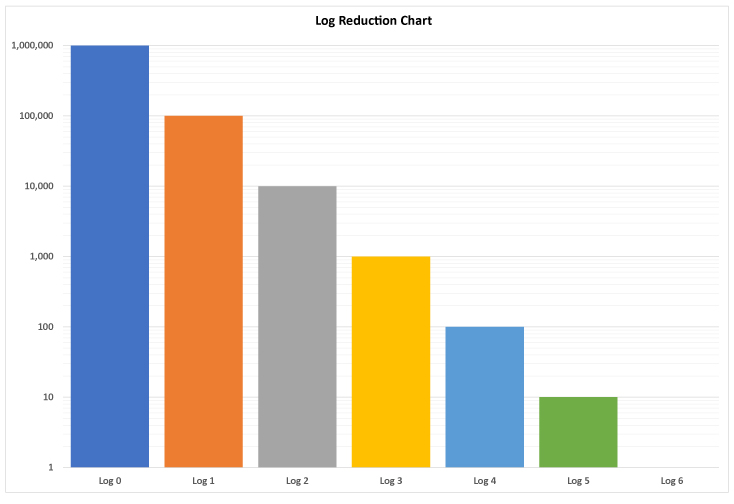
08 Jun Part 2: Reduction of Viable Bacteria Using Biocides
We started with the marketing of disinfectants as being labelled as a percentage reduction, and we said that 99.9% reduction sounded like it was almost 100%. However, we now know that unchecked bacteria can grow into enormous populations numbering into the millions, billions and trillions of bacteria cells.
From the previous example:
A kitchen worktop that was used to prepare raw chicken for dinner at around 6pm. The worktop is now contaminated with E.coli and the cleaning has not been as thorough as it should. The next morning at around 8am, the worktop is used to prepare breakfast. How many generations have passed from 6pm to 8 am? There are 3 generations per hour and 14 hours have passed, therefore there has been 42 generations (3 x 14). Under ideal conditions, that one cell has produced 4.4 trillion cells, or 4.400,000,000,000 cells!
If we use a sanitiser with a 99.9% kill rate to clean the surface after 14 hours, 0.1% of this enormous number is 4.4 billion – still a huge number.
In real life, a surface is not contaminated by just one bacterium, but many thousands and millions. So, even though the time between cleans may only be a few hours, but it starts with a large population and increases from that.
You can see how a surface can very quickly become contaminated by millions and billions of bacterial cells, and a reduction of 99.9% will still leave a large number of viable bacterial cells.
Moving from domestic disinfectants to commercial ‘infection control’ products, the marketing is significantly different and much more tightly controlled. You will see reduction rates marked as a percentage, but much more likely you will see labels like, “Log5 reduction”. This label, like the percentages, refers to how effective the disinfectant is at reducing the bacterial population, however, there are very important differences. Log is short for a logarithm and is a mathematical term to describe how many times a number (number 10 in this case) is multiplied by itself to reach another number.
For example:
Log 2 = 10 X 10 = 100
Log 3 = 10 X 10 X 10 = 1000
Log 4 = 10 X 10 X 10 X 10 = 10,000
Log 5 = 10 X 10 X 10 X 10 X 10 = 100,000
So, a Log 5 reduction in the bacterial population is 100,000 times smaller. So if the starting population is 1,000,000 (1 million), a log 5 reduction (100,000 times smaller) will result in just 10. We can convert these log reductions into percentage reductions:


Please note the scaling on the y-axis, for every step the population reduces by 10 times.
We can see that our original sanitiser labelled as 99.9% corresponds to a Log 3 reduction and for every 1 million bacterial cells, one thousand (1,000) will remain viable. Whereas a commercial disinfectant – at a minimum – will result in a log 5, but more likely result in a log 6 reduction, or only 1 to 10 cells. There is a big difference between 1 and 1000 cells left on the surface. It just goes to show that a percentage is misleading.
Global commercial disinfectants are tested and certified to either BS EN 1276 or listed on the EPA register. Both certification systems stipulate a minimum Log 5 reduction in 5 minutes. This is your standard for purchasing and using disinfectants.

